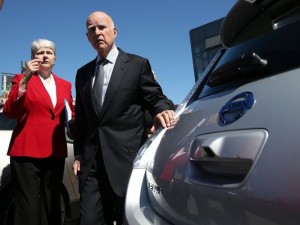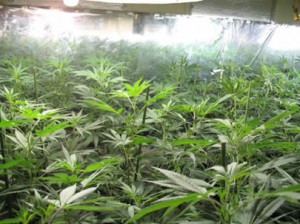My colleague and faculty director, Dan Farber, described in an op-ed on CNN.com the multiple ways that we can clean our air, from the local to state to federal levels. Dan gives a nice shout-out to my book Railtown, using it to show how Los Angeles could implement more low-cost solutions to get residents to use transit over driving.
In addition to more public transit, Dan highlights electric vehicles, clean fleets such as cabs, and EPA regulation of power plants as necessary steps to make our air cleaner and improve public health and the climate as a result.
 This past Friday in Sacramento, the Office of California Governor Jerry Brown convened a few hundred electric vehicle experts for an update on California’s progress deploying EVs. The attendees were mostly from California, including utility representatives, advocates, researchers, and officials. However, experts also came from places ranging from Oregon to the Netherlands. Some informational highlights from the conversation:
This past Friday in Sacramento, the Office of California Governor Jerry Brown convened a few hundred electric vehicle experts for an update on California’s progress deploying EVs. The attendees were mostly from California, including utility representatives, advocates, researchers, and officials. However, experts also came from places ranging from Oregon to the Netherlands. Some informational highlights from the conversation:
- The Netherlands recently reached a major milestone: 25% of their new car sales were electric vehicles. Part of the appeal: the Netherlands waived the sales tax on EVs and has invested heavily in charging stations. Maybe a good lesson for California as EV rebate money runs out? Waiving the sales tax on EVs, if it could pass the Legislature, would be a great incentive for purchase.
- Most Nissan LEAF, Chevy Volt, and Toyota Plug-In Prius customers were motivated by the environmental benefits and fuel savings. Tesla customers, however, were primarily motivated by vehicle performance and access to new technology. Survey results found here (collected by the entity that sends out vehicle rebates, which is a great source of market data like these).
- Most electric vehicle customers skew to the older, whiter, more highly educated, and male demographic.
- HOV (carpool) lane access was an “extremely or a very important purchase motivation” for 59% of EV customers. This bodes poorly for California as the state is running out of carpool lane stickers to distribute — like in a matter of months. The Governor’s Office vowed to make addressing this need a priority.
- California sales of EVs currently represent one-third of the national market, with 64,649 sold to date. The sales graph is definitely looking like a hockey stick, which is an incredible advance for the technology.
- An electric utility rep says that sales of California’s low carbon fuel credits could mean $200 a year back in the pockets of EV drivers. The low carbon fuel standard is part of California’s efforts to reduce greenhouse gas emissions to 1990 levels by 2020, and it requires fuel refiners to either limit the carbon content of their fuel or purchase credits on the open market. Since electric utilities are providing low-carbon fuel (electricity) to their EV customers, the utilities get to sell the credit to oil companies and then return the money to the EV drivers. And if the utility is saying $200 a year, it’s probably more like $500 a year, which is basically free charging at home for most EV drivers.
- Atlanta is the number 2 market in the US for Nissan LEAFs, due to HOV access and other state incentives in a congested urban area. San Francisco is #1 and Honolulu is #6 (and it could rise to the top in terms of percent of EVs sold each year). Even Nashville clocked in at #9. I like see red state cities showing up on this list. EVs should be a bipartisan priority.
Ultimately, the Friday convening was a success in terms of sharing the latest information, providing participants with a chance to influence state priorities on EVs, and giving people in the field a motivational boost. The state is doing incredibly well in terms of EV adoption, as the hockey stick sales graph and anecdotal observations can attest. Look for the key near-term priorities to be an extension of the HOV sticker program and making that low carbon fuel standard rebate happen quickly.
Full speed ahead, California EV drivers and those who will soon be one!
 Now that the two states that just legalized marijuana sent their football teams to the Superbowl this year, it’s clear that the stars are aligning for legalizing marijuana nationwide. Sure, legalizing marijuana makes fiscal, moral, and practical sense, but what about the benefits to the environment? Well, it turns out that even the fight against climate change could potentially be enhanced by making cannabis — and the grow operations that produce it — legal.
Now that the two states that just legalized marijuana sent their football teams to the Superbowl this year, it’s clear that the stars are aligning for legalizing marijuana nationwide. Sure, legalizing marijuana makes fiscal, moral, and practical sense, but what about the benefits to the environment? Well, it turns out that even the fight against climate change could potentially be enhanced by making cannabis — and the grow operations that produce it — legal.
It starts with the grow sites. Regular Legal Planet readers may recall co-blogger Rick Frank writing about the local hazards and pollution caused by illegal grow operations on public lands. But there’s another, potentially broader environmental issue at stake with legalizing and mainstreaming grow operations: enabling the improved collection of energy data to help target energy conservation and efficiency programs.
Energy data are critical to the fight against climate change and other harmful forms of air pollution. Policy makers, especially here in California (as represented by Ken Alex, Legal Planet guest blogger and senior advisor to Governor Jerry Brown), would like to get a better sense of where the most energy is being used. If they could access energy data by neighborhoods, industry, and time of use, among other categories, policy makers could target the most inefficient customers with incentives and rates to become more efficient. Reducing this electricity usage would have major benefits in terms of reducing air pollution (including greenhouse gas emissions) from power plants and saving ratepayers money from the avoided construction of new plants. Not to mention that the customers themselves would benefit from paying for less electricity.
So what is standing in the way of giving policy makers access to the vital data? Privacy concerns. Even though the energy data are anonymized and aggregated, a vocal segment of ratepayers doesn’t like even the remote possibility that the government could use these data to know when you’re home, when you leave for work, or how your business operates.
Overall, most people have little to hide when it comes to electricity usage. But indoor marijuana growers sure do, and they are quietly constituting a major force in opposition to greater disclosure of energy data. And they have reason for concern. In documented cases, police have issued subpoenas for electricity data to bust pot growers. This is not a small industry either: a 2012 study by Evan Mills of the Lawrence Berkeley National Laboratory (the Lab was not involved in his work) indicated that these grow operations could be responsible for up to 2% of nationwide household electricity usage, at a total cost of $6 billion (in fact, the growers themselves may be our first target for implementing improved efficiency measures, given their potentially wasteful, unregulated ways).
So it’s not a stretch to think that legalizing marijuana nationwide, and allowing commercial grow operations to proceed in a regulated fashion, could have the additional benefit of defusing some of the major privacy objections to releasing environmentally beneficial energy data. Of course, the privacy objections aren’t just limited to marijuana growers, and even with legalization, some residential growers may still want or need to remain anonymous. But sensible marijuana policies could make a major difference in alleviating privacy concerns, unlocking the data that can lead to sound and strategic energy efficiency programs.
Sounds like a result everyone should be high on.
Here is my Sunday Sacramento Bee op-ed on renewable energy policies that California should adopt to reduce greenhouse gas emissions.


